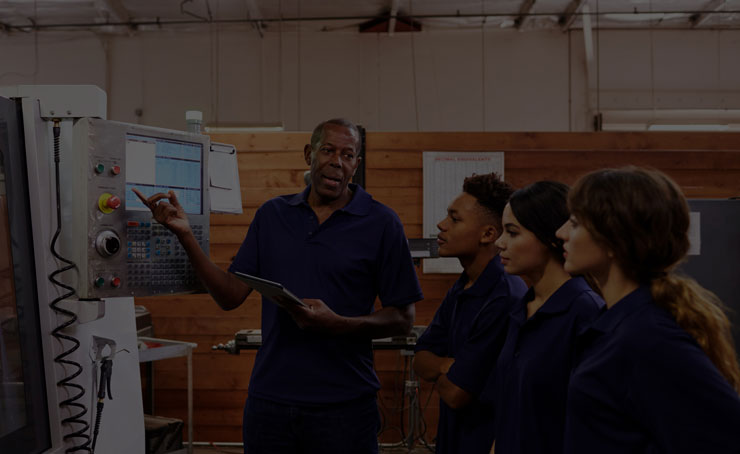Be a Blog Subscriber
Join thousands of manufacturing leaders and professionals who get the Accelerate blog delivered straight to their inbox


I recently had the privilege of presenting at The Best of SMX on the topic of “Accelerating Workforce Performance Through Learning and Development Best Practices.” It was exciting to be part of a virtual event where industry thought leaders shared insights into the opportunities and challenges manufacturers face as they transform their operations with advanced digital technologies.
One of the consistent themes throughout the event was the importance of a skilled workforce, which I approached from several different angles during my presentation. Following are a few key points.
We’re currently in a post-pandemic economy, but the supply chain is coming back and we still have the huge manufacturing skills gap we had before COVID-19 started. Researchers predict there will be 2.4 million unfilled manufacturing jobs nationwide by 2028 due to a skills shortage, while pointing out that it takes an average of 70 days to recruit skilled production workers.1
Without a strong learning culture, skills will remain behind innovation, and the skills gap will be ongoing. While on-the-job training helps close the skills gap, another key factor is influencing workforce performance — a generational shift marked by Gen Xers (born 1961-1980), millennials (1981-1995) and Gen Zers (post-1995) who are moving into job roles formerly occupied by baby boomers (1945-1960) and “maturists” (pre-1945).
The bottom line is that you need people to run and maintain your company, and you want people to stay. But you’re not just competing with other manufacturers. You’re also competing with other industries that are attracting and retaining people with structured on-the-job training that demonstrates a clear career pathway.
A 2018 study conducted by the Work Institute showed that the number one reason people leave their jobs is career development.2 This is a direct reflection of a younger generation that is made up of gamers. They’re all looking for extra ammo and the golden pineapple, and, in the case of their careers, they’re looking for the pathway to get to the next level.
Not only do younger generations communicate differently and make decisions differently, they have different attitudes toward their careers. They’re not going to stay at one company for their entire career because they want to get a gold watch. So when you’re thinking about learning and development best practices, you’ve got to think about how to attract and retain these younger generations.
In order to become an employer of choice — that is, a company where younger generations want to work and to stay — you need to develop a high-impact learning culture, which will benefit your organization in several ways. According to a study by Bersin & Associates, high-impact learning organizations (HILOs) tend to significantly outperform their peers in several key areas: the time it takes to get to market, employee productivity, customer service, product quality, the skills to meet future demand, and the likelihood of becoming market share leaders.1
But to become a HILO, you have to avoid falling into the same old trap of saying, “This worked in the past.” If you think you’re going to keep your workers performing at a high level by using traditional, unstructured, on-the-job training or one-and-done training methods, you’re kidding yourself. We can’t just set someone on a job, show them how to do it one time and then walk away. It no longer works, no matter how simple the job is, because many of the people coming in haven’t come from a manufacturing background.
How do you go about developing a high-impact learning culture? Defining your profiles and competencies is the logical place to begin. Understanding your company’s job roles, the knowledge and skills employees need to succeed, and how employees progress within your company is the first critical step to a sustainable and strategic workforce development program that meets current as well as future business needs.
The use of mobile devices for social learning is a key ingredient in building a high-impact learning culture, as younger generations are accustomed to communicating and interacting with their employers through these devices. Organizations need to find ways to embed training and performance support in social learning, such as blending discussion groups with formal learning practices. Employee networks, mentoring programs and established communities of practice can all operate through commonly used social media applications.
As you’re developing a structured training plan, keep in mind that the platforms for delivering training are shifting from personal computers to mobile applications to advanced technologies such as virtual reality, augmented reality and mixed reality. These new technologies can bridge the gap between foundational knowledge and on-the-job training so that workers can apply the knowledge they’ve gained from elearning and instructor-led classes in a virtual environment before actually working on a half-a-million-dollar piece of equipment. As a result, your workers will be more engaged; they will progress quicker, and your company will be more likely to retain them.
The information contained within this blog just scratches the surface of my presentation at the Best of SMX. To hear my entire presentation, as well as all the other recorded sessions from the event, visit virtual.smxevent.com/ through January 30, 2021.
And keep in mind that Tooling U-SME has dozens of new elearning classes available, including courses on smart manufacturing topics, such as additive manufacturing, cybersecurity, data collection and machine learning.
To learn more about our workforce training programs, reach out to us at 866.706.8665.
Join thousands of manufacturing leaders and professionals who get the Accelerate blog delivered straight to their inbox